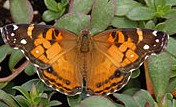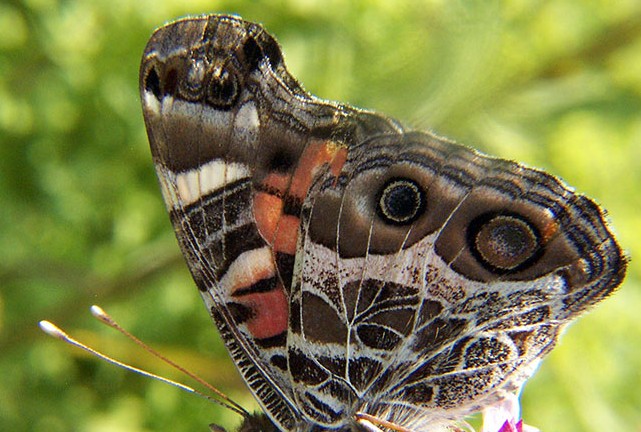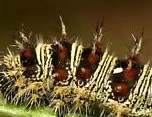 The American lady butterfly is a common sight in open areas such as gardens, meadows, roadsides and vacant lots in North America. It is at home in southern US to Colombia, South American but migrates up into northern US and southern Canada in warm weather. With a wing span of 1 ¾ to 2 5/8 inches, it is orange on the topside with irregular brown to black and white markings.
The American lady butterfly is a common sight in open areas such as gardens, meadows, roadsides and vacant lots in North America. It is at home in southern US to Colombia, South American but migrates up into northern US and southern Canada in warm weather. With a wing span of 1 ¾ to 2 5/8 inches, it is orange on the topside with irregular brown to black and white markings.
 Early season individuals are larger and more colorful than late season ones. American painted lady can be distinguished from two related species by the presence of two large eyespots on the underside of their hind wing.
Early season individuals are larger and more colorful than late season ones. American painted lady can be distinguished from two related species by the presence of two large eyespots on the underside of their hind wing.
 Males exhibit hilltopping behavior, flying up to perch on hill summits looking for females. After mating, females lay single yellow-green eggs on the top of host plants. When the tiny caterpillars hatch from yellow-green eggs in spring they make a nest by curling the host plant’s leaves around their bodies and secure it with silk. They hide in the nests during the day but come out to feed at night and on overcast days. The caterpillars are 1 3/8 inches long and have black and yellow striped bodies with white spots and branched spines with red base. They may appear yellow or black depending on the relative width of the stripes. At the end of the feeding period the caterpillars form a green or grey pupa flecked with gold and develop into butterflies by summer.
Males exhibit hilltopping behavior, flying up to perch on hill summits looking for females. After mating, females lay single yellow-green eggs on the top of host plants. When the tiny caterpillars hatch from yellow-green eggs in spring they make a nest by curling the host plant’s leaves around their bodies and secure it with silk. They hide in the nests during the day but come out to feed at night and on overcast days. The caterpillars are 1 3/8 inches long and have black and yellow striped bodies with white spots and branched spines with red base. They may appear yellow or black depending on the relative width of the stripes. At the end of the feeding period the caterpillars form a green or grey pupa flecked with gold and develop into butterflies by summer.
To entice the adults to your garden plant daisies (Leucanthemum spp.), goldenrod (Solidago spp.), marigold (Tagetes spp), yarrow (Achillea spp), zinnia (Zinnia spp), common selfheal (Prunella vulgaris), mallow (Althaea officinalis), asters (Aster spp), and common milkweed (Asclepias syriaca). On order to provide for the caterpillars, plant pearly everlasting (Anaphalis margaritacea) plantian leaved pussytoes (Antennaria plantaginifolia, wormwood (Artemisia absinthium), and ironweed (Veronia spp.) and everlasting (Gnaphalium obtusifolium).